《认知心理学》课程教学资源(书籍文献)Cognitive Neuroscience - The Biology of the Mind,Fourth Edition,Michael S. Gazzaniga, Richard B. Ivry, and George R. Mangun
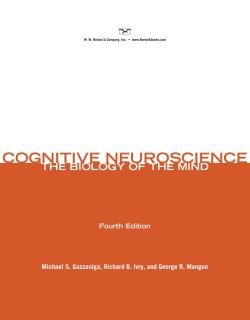
G W.W.Norton&Company,Inc.www.NortonEbooks.com COGNT%8RR后NCE Fourth Edition Michael S.Gazzaniga,Richard B.Ivry,and George R.Mangun
COGNITIVE NEUROSCIENCE Michael S. Gazzaniga, Richard B. Ivry, and George R. Mangun THE BIOLOGY OF THE MIND Fourth Edition
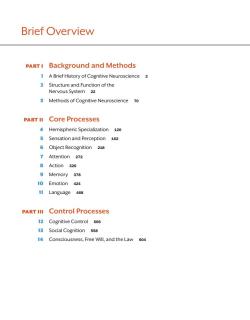
Brief Overview PARTI Background and Methods 1 A Brief History of Cognitive Neuroscience 2 2 Structure and Function of the Nervous System 22 3 Methods of Cognitive Neuroscience 70 PARTII Core Processes 4 Hemispheric Specialization 120 5 Sensation and Perception 162 6 Object Recognition 218 7 Attention 272 8 Action 326 9 Memory 378 10 Emotion 424 11 Language 468 PARTI Control Processes 12 Cognitive Control 506 13 Social Cognition 558 14 Consciousness,Free Will,and the Law 604
PART I Background and Methods 1 A Brief History of Cognitive Neuroscience 2 2 Structure and Function of the Nervous System 22 3 Methods of Cognitive Neuroscience 70 PART II Core Processes 4 Hemispheric Specialization 120 5 Sensation and Perception 162 6 Object Recognition 218 7 Attention 272 8 Action 326 9 Memory 378 10 Emotion 424 11 Language 468 PART III Control Processes 12 Cognitive Control 506 13 Social Cognition 558 14 Consciousness, Free Will, and the Law 604 Brief Overview 00i_xviii_Cogneu_4e_FM.indd iv 8/1/13 1:22 PM

Contents ace Acknowledgments xv PARTI Background and Methods 1 A Brief History of Cognitive Overview of Nervous System Structure 37 Neuroscience 2 The Autonomic Nervous System 38 The Central Nervous System 38 AHistorical Perspective 4 40 The Brain Story 5 The Psychological Story 10 The Brainstem:M edulla,Pons,Cerebellum The Instruments of Neuroscience 14 and Midbrain 43 The Electroencephalograph 14 The Diencephalon:Thalamus and Measuring Blood Flow in the Brain 15 Hypothalamus 45 Computerized Axial Tomography 15 The Telencephalon:Limbic System.Basal Positron Emission Tomography and Ganglia,and Cerebral Cortex 47 Radioactive Tracers 16 The Cerebral Cortex 49 Magnetic Rea maging Dividing the Cortex Anatomically 50 Functional Magnetic Resonance Imaging 17 Dividing the Cortex Cytoarchitectonically 51 The Book in Your Hands 19 Functional Divisions of the Cortex 53 Development of the Nervous System 60 2 Structure and Function of the Overvie oss Developmen Nervous System 22 w Neurons Throughout Lit 64 The Baby Brain:Ready to Rock'n'Roll? 66 The Structure of Neurons 24 Neuronal Signaling 27 3 The Membrane Potential 27 Methods of Cognitive The Action Potential 30 Neuroscience 70 Synaptic Transmission 32 Cognitive Psychology and Behavioral Methods 74 Chemical Tran 32 Ferreting Out Mental Representations and rotrans 33 Transformations 74 Constraints on Information Processing 78 Release Studying the Damaged Brain 78 Electrical Transmission 35 Causes of Neurological Dysfunction 79 The Role of Glial Cells 35 Studying Brain-Behavior Relationships The Bigger Picture 37 Following Neural Disruption 83 Functional Neurosurgery:Intervention to Alter or Restore Brain Function 86
Contents Boxes xii Preface xiii Acknowledgments xv 1 A Brief History of Cognitive Neuroscience 2 A Historical Perspective 4 The Brain Story 5 The Psychological Story 10 The Instruments of Neuroscience 14 The Electroencephalograph 14 Measuring Blood Flow in the Brain 15 Computerized Axial Tomography 15 Positron Emission Tomography and Radioactive Tracers 16 Magnetic Resonance Imaging 17 Functional Magnetic Resonance Imaging 17 The Book in Your Hands 19 2 Structure and Function of the Nervous System 22 The Structure of Neurons 24 Neuronal Signaling 27 The Membrane Potential 27 The Action Potential 30 Synaptic Transmission 32 Chemical Transmission 32 Neurotransmitters 33 Inactivation of Neurotransmitters after Release 34 Electrical Transmission 35 The Role of Glial Cells 35 The Bigger Picture 37 Overview of Nervous System Structure 37 The Autonomic Nervous System 38 The Central Nervous System 38 A Guided Tour of the Brain 40 The Spinal Cord 40 The Brainstem: Medulla, Pons, Cerebellum, and Midbrain 43 The Diencephalon: Thalamus and Hypothalamus 45 The Telencephalon: Limbic System, Basal Ganglia, and Cerebral Cortex 47 The Cerebral Cortex 49 Dividing the Cortex Anatomically 50 Dividing the Cortex Cytoarchitectonically 51 Functional Divisions of the Cortex 53 Development of the Nervous System 60 Overview of Gross Development 60 Birth of New Neurons Throughout Life 64 The Baby Brain: Ready to Rock ’n’ Roll? 66 3 Methods of Cognitive Neuroscience 70 Cognitive Psychology and Behavioral Methods 74 Ferreting Out Mental Representations and Transformations 74 Constraints on Information Processing 78 Studying the Damaged Brain 78 Causes of Neurological Dysfunction 79 Studying Brain–Behavior Relationships Following Neural Disruption 83 Functional Neurosurgery: Intervention to Alter or Restore Brain Function 86 PART I Background and Methods v 00i_xviii_Cogneu_4e_FM.indd v 8/1/13 1:22 PM
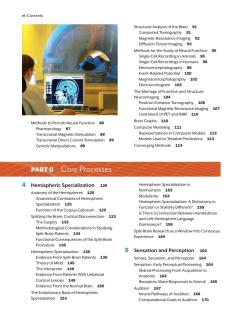
vi Contents Structural Analysis of the Brain 91 Computed Tomography 91 Magnetic Resonance Imaging 92 Diffusion Tensor Imaging 93 Methods for the Study of Neural Function 95 Single-Cell Recording in Animals 95 Single-Cell Recordings in Humans 98 Electroencephalography 98 Event-Related Potential 100 Magnetoencephalography 102 trocortogram 102 The Marriage of Function and Structure: Neuroimaging 104 Positron Emission Tomography 105 Functional Magnetic Resonance Imaging 107 Limitations of PET and fMRI 110 Methods to Perturb Neural Function 86 Brain Graphs 110 Pharmacol Computer Modeling 111 lagnetic Stimulation 88 Representations in Computer Models 113 anscranial Direct Current Stimulation 89 Models Lead to Testable Predictions 113 Genetic Manipulations 89 Converging Methods 114 PART II Core Processes 4 Hemispheric Specialization 120 Hemispheric Specialization in Anatomy of the Hemispheres 125 Nonhumans 153 Modularity 154 Anatomical Correlates of Hemispheric Hemi Specialization 125 ialization:A Dichotomy in Function of the Corpus Callosum 129 Function or Styishly Different?55 re a Connection Between Handedness Splitting the Brain:Cortical Disconnection 133 The Surgery 133 and Left-He Methodological Considerations in Studying Dominance? Split-Brain Patients 134 Split-Brain Research as a Window into Conscious Experience 159 Functional Consequences of the split-Brain Procedure 135 Hemispheric Specialization 136 5 Sensation and Perception 162 Evidence From Split-Brain Patients 136 Senses,Sensation,and Perception 164 Theory of Mind 145 Sensation:Early Perceptual Processing 164 The Interpreter 146 Shared Proc ing From Acquisition to Evidence From Patients With Unilateral Cortical Lesions 149 Anatomy 164 Receptors Share Responses to Stimuli 165 Evidence From the Normal Brain 150 Audition 167 The Evolutionary Basis of Hemispheric Neural Pathways of Audition 168 Specialization 153 Computation Goals in Audition 10
vi | Contents 4 Hemispheric Specialization 120 Anatomy of the Hemispheres 125 Anatomical Correlates of Hemispheric Specialization 125 Function of the Corpus Callosum 129 Splitting the Brain: Cortical Disconnection 133 The Surgery 133 Methodological Considerations in Studying Split-Brain Patients 134 Functional Consequences of the Split-Brain Procedure 135 Hemispheric Specialization 136 Evidence From Split-Brain Patients 136 Theory of Mind 145 The Interpreter 146 Evidence From Patients With Unilateral Cortical Lesions 149 Evidence From the Normal Brain 150 The Evolutionary Basis of Hemispheric Specialization 153 Hemispheric Specialization in Nonhumans 153 Modularity 154 Hemispheric Specialization: A Dichotomy in Function or Stylishly Different? 155 Is There a Connection Between Handedness and Left-Hemisphere Language Dominance? 156 Split-Brain Research as a Window into Conscious Experience 159 5 Sensation and Perception 162 Senses, Sensation, and Perception 164 Sensation: Early Perceptual Processing 164 Shared Processing From Acquisition to Anatomy 164 Receptors Share Responses to Stimuli 165 Audition 167 Neural Pathways of Audition 168 Computational Goals in Audition 170 PART II Core Processes Structural Analysis of the Brain 91 Computed Tomography 91 Magnetic Resonance Imaging 92 Diffusion Tensor Imaging 93 Methods for the Study of Neural Function 95 Single-Cell Recording in Animals 95 Single-Cell Recordings in Humans 98 Electroencephalography 98 Event-Related Potential 100 Magnetoencephalography 102 Electrocortogram 102 The Marriage of Function and Structure: Neuroimaging 104 Positron Emission Tomography 105 Functional Magnetic Resonance Imaging 107 Limitations of PET and fMRI 110 Brain Graphs 110 Computer Modeling 111 Representations in Computer Models 113 Models Lead to Testable Predictions 113 Converging Methods 114 Methods to Perturb Neural Function 86 Pharmacology 87 Transcranial Magnetic Stimulation 88 Transcranial Direct Current Stimulation 89 Genetic Manipulations 89 00i_xviii_Cogneu_4e_FM.indd vi 8/1/13 1:22 PM
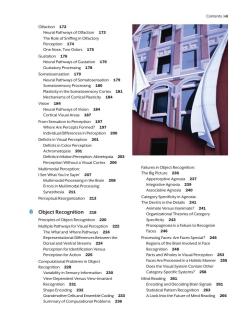
Contents|vii Olfaction 172 Neural Pathways of Olfaction 173 The Role of Sniffing in Olfactory Perception 174 One Nose,Two Odors 175 176 vays of Gustation 176 Gustatory Processing 178 Somatosensation 179 Neural Pathways of Somatosensation 179 Somatosensory Pro sing 180 nsory Corte 181 184 Vision 184 Neural Pathways of Vision 184 Cortical Visual Areas 187 From Sensation to Perception 197 Where Are Percepts Formed? 197 Individual Differences in Perception 200 Deficits in Visual Perception 201 Deficits in Color Pere ption: sia 203 Perception Without a Visual Cortex 206 Multimodal Perception: Failures in Object Recognition I See what You're Savin'207 The Big Picture 236 Multimodal Processing in the Brain 208 Apperceptive Agnosia 23 Errors in multimodal p Integrative Agnosia 23 Synesthesia 211 Associative Agnosia 240 Perceptual Reorganization 213 241 6 Object Recognition 218 241 heories of Category Principles of Object Recognition 220 Specificity 243 Multiple Pathways for Visual Perception 222 Prosopagnosia ls a Failure to Recognize The Whatand Where Pathways 224 Faces 246 entational Diffe n the Dorsal and Ven tral st 224 Regions d in Face Perception for ldentificati nVersus Recognitic Perception for Action 25 Parts and Wholes in Visual Perc tior Computational Problems in Object Faces Are Processed in a Holistic Manne Recognition 228 Does the Visual System Contain Other Variability in Sensory Information 230 Categorv-Specific Systems?258 View-De ndent Versus View-Invari Mind Reading 261 Recognition 231 Encoding and De coding Brain Sig 261 Shape Encoding 232 tatisti l Pattern Re <63 Grandmother Cells and Ensemble Coding 233 A Look Into the Future of Mind Reading 266 Summary of Computational Problems 236
Contents | vii Olfaction 172 Neural Pathways of Olfaction 173 The Role of Sniffi ng in Olfactory Perception 174 One Nose, Two Odors 175 Gustation 176 Neural Pathways of Gustation 176 Gustatory Processing 178 Somatosensation 179 Neural Pathways of Somatosensation 179 Somatosensory Processing 180 Plasticity in the Somatosensory Cortex 181 Mechanisms of Cortical Plasticity 184 Vision 184 Neural Pathways of Vision 184 Cortical Visual Areas 187 From Sensation to Perception 197 Where Are Percepts Formed? 197 Individual Differences in Perception 200 Defi cits in Visual Perception 201 Defi cits in Color Perception: Achromatopsia 201 Defi cits in Motion Perception: Akinetopsia 203 Perception Without a Visual Cortex 206 Multimodal Perception: I See What You’re Sayin’ 207 Multimodal Processing in the Brain 208 Errors in Multimodal Processing: Synesthesia 211 Perceptual Reorganization 213 6 Object Recognition 218 Principles of Object Recognition 220 Multiple Pathways for Visual Perception 222 The What and Where Pathways 224 Representational Differences Between the Dorsal and Ventral Streams 224 Perception for Identifi cation Versus Perception for Action 225 Computational Problems in Object Recognition 228 Variability in Sensory Information 230 View-Dependent Versus View-Invariant Recognition 231 Shape Encoding 232 Grandmother Cells and Ensemble Coding 233 Summary of Computational Problems 236 Failures in Object Recognition: The Big Picture 236 Apperceptive Agnosia 237 Integrative Agnosia 239 Associative Agnosia 240 Category Specifi city in Agnosia: The Devil Is in the Details 241 Animate Versus Inanimate? 241 Organizational Theories of Category Specifi city 243 Prosopagnosia Is a Failure to Recognize Faces 246 Processing Faces: Are Faces Special? 246 Regions of the Brain Involved in Face Recognition 248 Parts and Wholes in Visual Perception 253 Faces Are Processed in a Holistic Manner 255 Does the Visual System Contain Other Category-Specifi c Systems? 258 Mind Reading 261 Encoding and Decoding Brain Signals 261 Statistical Pattern Recognition 263 A Look Into the Future of Mind Reading 266 00i_xviii_Cogneu_4e_FM.indd vii 8/1/13 1:22 PM
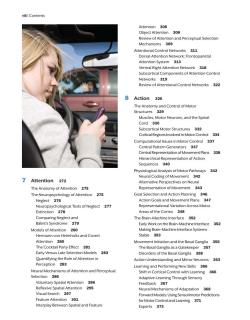
viii|Contents Attention 306 Obiect Attention 308 Review of Attention and Perceptual selection Mechanisms 309 Attentional Control Networks 311 Dorsal Attention Network:Frontoparietal Attention System 313 Ventral Right Attention Network 318 Subcortical Components of Attention Control Networks 319 Review of Attentional Control Networks 322 8 Action 326 The Anatomy and Control of Motor Structures 329 Muscles motor Neu rons,and the Spinal Cord 330 Sut ortical Motor Structures 332 Cortical Regions Involved in Motor Control 334 Computational Issues in Motor Control 337 Central Pattern Generators 337 Central Representation of Move ent Plans 338 Hierarchic al Re ntation of Ac tior Sequences 340 Physiological Analysis of Motor Pathways 342 Neural Coding of Movement 342 7 Attention 272 Alternative perspectives on Neural The Anatomy of Attention 275 Representation of movement 343 The Neuropsychology of Attention 275 Goal Selection and Action Planni 346 Neglect 276 Action Goals and Movement Plans 347 Neuropsychological Tests of Neglect 277 Representational Variation Across Motor Extinction 278 Areas of the Cortex 348 Comparing Neglect and The Brain-Machine Interface 352 Balint's Syndrome 279 rly Work on the rai 352 Models of Attention 280 Hermann von Helmholtz and Covert Attention 280 Movement Initiation and the Basal Ganglia 356 The Cocktail Party Effect 281 The Basal Ganglia as a Gatekeeper 357 Early Versus Late Selection Models 283 Disorders of the Basal Ganglia 358 Quantifying the Role of Attention in Action Understanding and Mirror Neurons 363 Perception 283 Learning and Performing New Skills 366 Neural Mechanisms of Attention and Perceptual Shift in Cortical Control with Learning 366 Selection 286 Adaptive Learning Through Sensory Voluntary Spatial Attention 286 Feedback 367 Reflexive Spatial Attention 295 Neural Me nisms of Adaptatior 368 Visual Search 297 0 rd Models:Using Sensorim Feature Attention 301 for Motor Control and Learning 371 Interplay Bet n Spatial and Feature Experts 373
viii | Contents 7 Attention 272 The Anatomy of Attention 275 The Neuropsychology of Attention 275 Neglect 276 Neuropsychological Tests of Neglect 277 Extinction 278 Comparing Neglect and Bálint’s Syndrome 279 Models of Attention 280 Hermann von Helmholtz and Covert Attention 280 The Cocktail Party Effect 281 Early Versus Late Selection Models 283 Quantifying the Role of Attention in Perception 283 Neural Mechanisms of Attention and Perceptual Selection 286 Voluntary Spatial Attention 286 Refl exive Spatial Attention 295 Visual Search 297 Feature Attention 301 Interplay Between Spatial and Feature Attention 306 Object Attention 308 Review of Attention and Perceptual Selection Mechanisms 309 Attentional Control Networks 311 Dorsal Attention Network: Frontoparietal Attention System 313 Ventral Right Attention Network 318 Subcortical Components of Attention Control Networks 319 Review of Attentional Control Networks 322 8 Action 326 The Anatomy and Control of Motor Structures 329 Muscles, Motor Neurons, and the Spinal Cord 330 Subcortical Motor Structures 332 Cortical Regions Involved in Motor Control 334 Computational Issues in Motor Control 337 Central Pattern Generators 337 Central Representation of Movement Plans 338 Hierarchical Representation of Action Sequences 340 Physiological Analysis of Motor Pathways 342 Neural Coding of Movement 342 Alternative Perspectives on Neural Representation of Movement 343 Goal Selection and Action Planning 346 Action Goals and Movement Plans 347 Representational Variation Across Motor Areas of the Cortex 348 The Brain–Machine Interface 352 Early Work on the Brain–Machine Interface 352 Making Brain–Machine Interface Systems Stable 353 Movement Initiation and the Basal Ganglia 356 The Basal Ganglia as a Gatekeeper 357 Disorders of the Basal Ganglia 358 Action Understanding and Mirror Neurons 363 Learning and Performing New Skills 366 Shift in Cortical Control with Learning 366 Adaptive Learning Through Sensory Feedback 367 Neural Mechanisms of Adaptation 368 Forward Models: Using Sensorimotor Predictions for Motor Control and Learning 371 Experts 373 00i_xviii_Cogneu_4e_FM.indd viii 8/1/13 1:22 PM
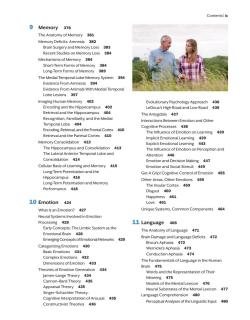
Contents ix 9 Memory 378 The Anatomy of Memory 381 Memory Deficits:Amnesia 382 Brain Surgery and Memory Loss 383 dies on Mer 384 Mechanisms of Memory 384 Short-Term Forms of Memory 384 Long-Term Forms of Memory 389 The Medial Temporal Lobe Me ory System 394 Evidence From Amnesia Medial Temporal Evidence From A Imaging Human Memory 402 436 Encoding and the Hippocampus 402 LeDoux's High Road Retrieval and the Hippocampus 404 The Amvedala 437 Interactions between emotion and other Temporal Lo obe 40a 438 Encoding,Retrieval,and the Frontal Corte 410 Retrieval and the Parietal Cortex 410 arning 439 43 Memory Consolidation 413 Explicit Emotional Learning 443 The Hippocampus and Consolidation 413 rior Tempor The Influence of Emotion on Perception and The lateral An all ob nd Attention 446 Consolidatior 414 Emotion and Decision Making 447 Cellular Basis of Learning and Memory 415 Emotion and Social Stimuli 449 Long-Term Potentiation and the Get A Grip!Cognitive Control of Emotion 455 Hippocampus 416 Long-Term Potentiation and Memory Other Areas,Other Emotions 459 The Insular Cortex 459 Performance 418 Disgust 460 Happiness 461 10 Emotion 424 Love 461 What Is an Emotion?427 Unique Systems,Common Components 464 Neural Systems Involved in Emotion Processing 11 Language 468 Early Concepts:The Limbic System as the The Anatomy of Language 471 Emotional Brain 428 Emerging Concepts of Emotional Networks 429 Brain Damage and Language Deficits 472 Broca's Aphasia 472 Wernicke's Aphasia 473 otions 431 Complex Emo 432 Conduction Aphasia 474 Dimensions of Emotion 433 The Fundamentals of Language in the Human Brain 475 Theories of Emotion Generation 434 Words and the Representation of Their James-Lange Theory 434 Meaning 475 Cannon-Bard Theory 435 Models of the Mental Lexicon 476 isal the 435 Neural Substrates of the mental Lexicon 477 -Schachter Theory: Cognitive Interpretation of Arousal Language Comp ehension 480 435 Perceptual Analyses of the Linguistic Input 480 Constructivist Theories 436
Contents | ix 9 Memory 378 The Anatomy of Memory 381 Memory Defi cits: Amnesia 382 Brain Surgery and Memory Loss 383 Recent Studies on Memory Loss 384 Mechanisms of Memory 384 Short-Term Forms of Memory 384 Long-Term Forms of Memory 389 The Medial Temporal Lobe Memory System 394 Evidence From Amnesia 394 Evidence From Animals With Medial Temporal Lobe Lesions 397 Imaging Human Memory 402 Encoding and the Hippocampus 402 Retrieval and the Hippocampus 404 Recognition, Familiarity, and the Medial Temporal Lobe 404 Encoding, Retrieval, and the Frontal Cortex 410 Retrieval and the Parietal Cortex 410 Memory Consolidation 413 The Hippocampus and Consolidation 413 The Lateral Anterior Temporal Lobe and Consolidation 414 Cellular Basis of Learning and Memory 415 Long-Term Potentiation and the Hippocampus 416 Long-Term Potentiation and Memory Performance 418 10 Emotion 424 What Is an Emotion? 427 Neural Systems Involved in Emotion Processing 428 Early Concepts: The Limbic System as the Emotional Brain 428 Emerging Concepts of Emotional Networks 429 Categorizing Emotions 430 Basic Emotions 431 Complex Emotions 432 Dimensions of Emotion 433 Theories of Emotion Generation 434 James–Lange Theory 434 Cannon–Bard Theory 435 Appraisal Theory 435 Singer–Schachter Theory: Cognitive Interpretation of Arousal 435 Constructivist Theories 436 Evolutionary Psychology Approach 436 LeDoux’s High Road and Low Road 436 The Amygdala 437 Interactions Between Emotion and Other Cognitive Processes 438 The Infl uence of Emotion on Learning 439 Implicit Emotional Learning 439 Explicit Emotional Learning 443 The Infl uence of Emotion on Perception and Attention 446 Emotion and Decision Making 447 Emotion and Social Stimuli 449 Get A Grip! Cognitive Control of Emotion 455 Other Areas, Other Emotions 459 The Insular Cortex 459 Disgust 460 Happiness 461 Love 461 Unique Systems, Common Components 464 11 Language 468 The Anatomy of Language 471 Brain Damage and Language Defi cits 472 Broca’s Aphasia 472 Wernicke’s Aphasia 473 Conduction Aphasia 474 The Fundamentals of Language in the Human Brain 475 Words and the Representation of Their Meaning 475 Models of the Mental Lexicon 476 Neural Substrates of the Mental Lexicon 477 Language Comprehension 480 Perceptual Analyses of the Linguistic Input 480 00i_xviii_Cogneu_4e_FM.indd ix 8/1/13 1:22 PM
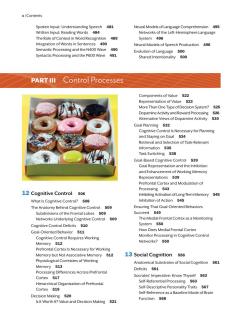
xIContents Spoken Input:Understanding Speech 481 Neural Models of Language Comprehension 495 Written Input:Reading Words 484 Networks of the Left-Hemisphere Language The Role of Context in Word Recognition 489 System 496 Integration of Words in Sentences 490 496 ing and the N400 Wav 4 Neural Models of Speech Production Evolution of Language 500 Syntactic Processing and the P600 Wave 9 Shared Intentionality 500 PART III Control Processes Components of Value 522 ntation of Value 522 on System? Dopamine Activity and Reward Processing Alternative Views of Dopamine Activity 530 Goal Planning 532 Cognitive Control Is Necessary for Planning and Staying on Goal 534 nd s election of Task-Relevant 53 Task Switching 538 Goal-Based Cognitive Control 539 Goal Representation and the Inhibition and Enhancement of Working Memory resentatio 539 x and Modulation of 12 Cognitive Control 506 nhibiting Acti on of Long-Term Memory 545 What Is Cognitive Control?508 Inhibition of Action 545 The Anatomy Behind Cognitive Control 509 Ensuring That Goal-Oriented Behaviors 09 Succeed 549 Networks Underlying Cognitive Control 509 The Medial Frontal Cortex as a Monitoring Cognitive Control Deficits 510 System Goal-Oriented Behavior 511 How Does Medial Frontal Cortex Monitor Processing in Cognitive Control Cognitive Co trol Requires Working Memory 512 Networks?550 Prefrontal Cortex Is Necessary for Working Memory but Not Associative Memory 512 13 Social Cognition 558 Physiological Correlates of Working Anatomical Substrates of Social Cognition 561 Memory 513 Deficits 561 Processing differences across prefrontal Cortex 517 e:Know Thyself 563 563 Cortex 519 Self-Descriptive Personality Traits 567 Self-Reference as a Baseline Mode of Brain Decision Making 520 Is It Worth It?Value and Decision Making 521 Function 568
x | Contents Spoken Input: Understanding Speech 481 Written Input: Reading Words 484 The Role of Context in Word Recognition 489 Integration of Words in Sentences 490 Semantic Processing and the N400 Wave 490 Syntactic Processing and the P600 Wave 491 Neural Models of Language Comprehension 495 Networks of the Left-Hemisphere Language System 496 Neural Models of Speech Production 496 Evolution of Language 500 Shared Intentionality 500 PART III Control Processes 12 Cognitive Control 506 What Is Cognitive Control? 508 The Anatomy Behind Cognitive Control 509 Subdivisions of the Frontal Lobes 509 Networks Underlying Cognitive Control 509 Cognitive Control Defi cits 510 Goal-Oriented Behavior 511 Cognitive Control Requires Working Memory 512 Prefrontal Cortex Is Necessary for Working Memory but Not Associative Memory 512 Physiological Correlates of Working Memory 513 Processing Differences Across Prefrontal Cortex 517 Hierarchical Organization of Prefrontal Cortex 519 Decision Making 520 Is It Worth It? Value and Decision Making 521 Components of Value 522 Representation of Value 522 More Than One Type of Decision System? 525 Dopamine Activity and Reward Processing 526 Alternative Views of Dopamine Activity 530 Goal Planning 532 Cognitive Control Is Necessary for Planning and Staying on Goal 534 Retrieval and Selection of Task-Relevant Information 535 Task Switching 538 Goal-Based Cognitive Control 539 Goal Representation and the Inhibition and Enhancement of Working Memory Representations 539 Prefrontal Cortex and Modulation of Processing 543 Inhibiting Activation of Long-Term Memory 545 Inhibition of Action 545 Ensuring That Goal-Oriented Behaviors Succeed 549 The Medial Frontal Cortex as a Monitoring System 550 How Does Medial Frontal Cortex Monitor Processing in Cognitive Control Networks? 550 13 Social Cognition 558 Anatomical Substrates of Social Cognition 561 Defi cits 561 Socrates’ Imperative: Know Thyself 563 Self-Referential Processing 563 Self-Descriptive Personality Traits 567 Self-Reference as a Baseline Mode of Brain Function 568 00i_xviii_Cogneu_4e_FM.indd x 8/1/13 1:22 PM
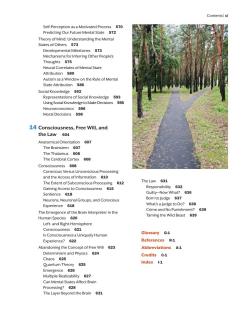
Contents|xl Self-Perception as a Motivated Process 570 Predicting Our Future Mental State 572 Theory of Mind:Understanding the Mental States of Others 573 tal Milestones 573 Inferring Other People's Thoughts 575 Neural Correlates of Mental State Attribution 580 Autism as a Window on the Role of Mental State Attribution 586 Social Knowledge 592 593 Using Social Knowledge to Make Decisions 695 Neuroeconomics 596 Moral Decisions 598 14 Consciousness,Free Will,and the Law 604 Anatomical Orientation 607 The Brainstem 607 The Thalan s608 The Cerebral Corte 608 Consciousness 608 Conscious Versus Unconscious Processing and the Access of Information 610 The Extent of Subconscious Processing 612 The Law 631 Gaining Access to Consciousness 615 Responsibility 632 Sentience 618 Guilty-Now What? 636 Neurons,Neur nal Groups,and Conscious Born to Judge 637 Experience 618 What's a Judge to Do?638 The Emergence of the Brain Interpreter in the Crime and No Punishment?639 Taming the Wild Beast 639 Human Species 620 Left-and Right-Hemisphere Conscious ness 621 s Consciousnessa Uniquely Human Glossary G-1 Experience? 622 References R-1 Abandoning the Concept of Free Will 623 Abbreviations A-1 Determinism and Physics 624 Credits c-1 Chaos 625 Quantum Theory 625 Index 1 ce626 Can Mental Stat Affect Brain Processing?628 The Layer Beyond the Brain 631
Contents | xi Self-Perception as a Motivated Process 570 Predicting Our Future Mental State 572 Theory of Mind: Understanding the Mental States of Others 573 Developmental Milestones 573 Mechanisms for Inferring Other People’s Thoughts 575 Neural Correlates of Mental State Attribution 580 Autism as a Window on the Role of Mental State Attribution 586 Social Knowledge 592 Representations of Social Knowledge 593 Using Social Knowledge to Make Decisions 595 Neuroeconomics 596 Moral Decisions 598 14 Consciousness, Free Will, and the Law 604 Anatomical Orientation 607 The Brainstem 607 The Thalamus 608 The Cerebral Cortex 608 Consciousness 608 Conscious Versus Unconscious Processing and the Access of Information 610 The Extent of Subconscious Processing 612 Gaining Access to Consciousness 615 Sentience 618 Neurons, Neuronal Groups, and Conscious Experience 618 The Emergence of the Brain Interpreter in the Human Species 620 Left- and Right-Hemisphere Consciousness 621 Is Consciousness a Uniquely Human Experience? 622 Abandoning the Concept of Free Will 623 Determinism and Physics 624 Chaos 625 Quantum Theory 625 Emergence 626 Multiple Realizability 627 Can Mental States Affect Brain Processing? 628 The Layer Beyond the Brain 631 The Law 631 Responsibility 632 Guilty—Now What? 636 Born to Judge 637 What’s a Judge to Do? 638 Crime and No Punishment? 639 Taming the Wild Beast 639 Glossary G-1 References R-1 Abbreviations A-1 Credits C-1 Index I-1 00i_xviii_Cogneu_4e_FM.indd xi 8/1/13 1:23 PM
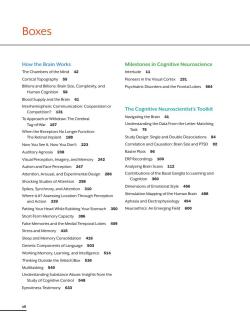
Boxes How the Brain Works Milestones in Cognitive Neuroscience The Chambers of the Mind 42 Interlude 11 Cortical Topography 55 Pioneers in the Visual Cortex 191 Billions and Billions:Brain Size,Complexity,and Psychiatric Disorders and the Frontal Lobes 564 Human Cognition 58 Blood Supply and the Brain 61 Interhemispheric Communication:Cooperation or Competition?131 The Cognitive Neuroscientist's Toolkit To Approach or Withdraw:The Cerebral Navigating the Brain 41 Tug-of-War 157 Understanding the Data From the Letter-Matching When the ReceptorsNoL Task 75 Study Design:Single and Double Dissociations 84 Now You See It,Now You Don't 223 Correlation and Causation:Brain Size and PTSD 92 Auditory Agnosia 238 Raster Plots 96 Visual Perception,Imagery,and Memory 242 ERP Recordings 100 Autism and Face Perception 247 Analyzing Brain Scans 112 Attention.Arousal and Experimental Design 286 Contributions of the Basal Ganglia to Learning and Shocking Studies of Attention 298 Cognition 360 Spikes,Synchrony,and Attention 310 Dimensions of Emotional Style 456 Where Is It?Assessing Location Through Perception Stimulation Mapping of the Human Brain 488 and Action 339 Aphasia and Electrophysiology 494 Patting Your Head While Rubbing Your Stomach 350 Neuroethics:An Emerging Field 600 Short-Term Memory Capacity 386 False Memories and the Medial Temporal Lobes 409 Stress and Memory 415 Sleep and Memory Consolidation 416 Genetic Components of Language 503 Working Memory,Learning,and Intelligence 514 Thinking Outside the(Match)Box 536 Multitasking 540 Understanding Substance Abuse:Insights from the Study of Cognitive Control 548 Eyewitness Testimony 633
xii How the Brain Works The Chambers of the Mind 42 Cortical Topography 55 Billions and Billions: Brain Size, Complexity, and Human Cognition 58 Blood Supply and the Brain 61 Interhemispheric Communication: Cooperation or Competition? 131 To Approach or Withdraw: The Cerebral Tug-of-War 157 When the Receptors No Longer Function: The Retinal Implant 188 Now You See It, Now You Don’t 223 Auditory Agnosia 238 Visual Perception, Imagery, and Memory 242 Autism and Face Perception 247 Attention, Arousal, and Experimental Design 286 Shocking Studies of Attention 298 Spikes, Synchrony, and Attention 310 Where Is It? Assessing Location Through Perception and Action 339 Patting Your Head While Rubbing Your Stomach 350 Short-Term Memory Capacity 386 False Memories and the Medial Temporal Lobes 409 Stress and Memory 415 Sleep and Memory Consolidation 416 Genetic Components of Language 503 Working Memory, Learning, and Intelligence 514 Thinking Outside the (Match)Box 536 Multitasking 540 Understanding Substance Abuse: Insights from the Study of Cognitive Control 548 Eyewitness Testimony 633 Milestones in Cognitive Neuroscience Interlude 11 Pioneers in the Visual Cortex 191 Psychiatric Disorders and the Frontal Lobes 564 The Cognitive Neuroscientist’s Toolkit Navigating the Brain 41 Understanding the Data From the Letter-Matching Task 75 Study Design: Single and Double Dissociations 84 Correlation and Causation: Brain Size and PTSD 92 Raster Plots 96 ERP Recordings 100 Analyzing Brain Scans 112 Contributions of the Basal Ganglia to Learning and Cognition 360 Dimensions of Emotional Style 456 Stimulation Mapping of the Human Brain 488 Aphasia and Electrophysiology 494 Neuroethics: An Emerging Field 600 Boxes 00i_xviii_Cogneu_4e_FM.indd xii 8/1/13 1:23 PM
按次数下载不扣除下载券;
注册用户24小时内重复下载只扣除一次;
顺序:VIP每日次数-->可用次数-->下载券;
- 《认知心理学》课程教学资源(书籍文献)认知科学与你的生活(原书第5版)美国名校学生最喜爱的心理学教材(美)凯瑟琳·加洛蒂(Kathleen M. Galotti)Cognitive Psychology - In and Out of the Laboratory,5th Edition.pdf
- 南方医科大学:《认知心理学》课程教学大纲 Cognitive psychology.pdf
- 《中国传统文化》课程教案讲义(打印版)第十六章 中外文化交流.pdf
- 《中国传统文化》课程教案讲义(打印版)第十一章 中国人生礼仪文化.pdf
- 《中国传统文化》课程教案讲义(打印版)第十章 中国饮食文化.pdf
- 《中国传统文化》课程教案讲义(打印版)第九章 中国服饰文化.pdf
- 《中国传统文化》课程教案讲义(打印版)第一章 文化简论.pdf
- 《中国传统文化》课程教学大纲(打印版)Introduction to Chinese Traditional Culture.pdf
- 《压力管理与心理健康》课程教学资源(教案讲义)第七章 消除压力,维护健康心理(打印版).pdf
- 《压力管理与心理健康》课程教学资源(教案讲义)第六章 压力自我调适的方法与技巧(打印版).pdf
- 《压力管理与心理健康》课程教学资源(教案讲义)第五章 认知重构与压力管理(打印版).pdf
- 《压力管理与心理健康》课程教学资源(教案讲义)第四章 人格特质与心理压力(打印版).pdf
- 《压力管理与心理健康》课程教学资源(教案讲义)第三章 大学生心理压力及应对(打印版).pdf
- 《压力管理与心理健康》课程教学资源(教案讲义)第二章 心理压力概述(打印版).pdf
- 《压力管理与心理健康》课程教学资源(教案讲义)第一章 绪论(打印版).pdf
- 《压力管理与心理健康》课程教学大纲(打印版)Stress management and mental health.pdf
- 上海电机学院:商学院毕业论文写作规范(2021版)毕业设计(论文)格式规范.docx
- 河南科技大学:信息工程学院本科课程教学大纲汇编(公共课).pdf
- 晋中学院生物科学与技术系:《中学生心理辅导》课程教学大纲 Psychological Counseling for Middle School Students.pdf
- 晋中学院生物科学与技术系:《班级管理学》课程教学大纲 Class Management.pdf
- 《认知心理学》课程教学资源(书籍文献)The Student’s Guide to Cognitive Neuroscience,Fourth Edition,by Jamie Ward SY.pdf
- 南方医科大学:《认知心理学》课程教学资源(课件讲稿)第一章 研究方法——认知神经科学(主讲:谭相良).pdf
- 《认知心理学》课程教学资源(书籍文献)认知神经科学——关于心智的生物学(美)MICHAEL S.GAZZANIGA,Cognitive Neuroscience The Biology of the Mind(3rd Edition,彩色电子版).pdf
- 《认知心理学》课程教学资源(书籍文献)Science研究破解“脸盲”奥秘 A fast link between face perception and memory in the temporal pole.pdf
- 《认知心理学》课程教学资源(书籍文献)中国心理学家揭示面孔身份识别和表情识别的关联机制 Emerged human-like facial expression representation in a deep convolutional neural network.pdf
- 《认知心理学》课程教学资源(书籍文献)聋人听觉皮层在感知觉功能重组中的作用 Reorganization of large-scale brain networks in deaf signing adults - The role of auditory cortex in functional reorganization following deafness.pdf
- 《认知心理学》课程教学资源(书籍文献)反射性注意的返回抑制起始时间可显著预测认知老化 Onset Time of Inhibition of Return Is a Promising Index for Assessing Cognitive Functions in Older Adults.pdf
- 《认知心理学》课程教学资源(书籍文献)注意缺陷多动障碍的视觉注意网络研究新发现 Neural Correlates of the Dual-Pathway Model for ADHD in Adolescents.pdf
- 《认知心理学》课程教学资源(书籍文献)神经与精神疾病(精神疾病的愉快体验加工和社会认知).pdf
- 南方医科大学:《认知心理学》课程教学资源(课件讲稿)第一章 认知心理——研究方法.pdf
- 南方医科大学:《认知心理学》课程教学资源(课件讲稿)第七章 记忆的认知神经机制.pdf
- 南方医科大学:《认知心理学》课程教学资源(课件讲稿)第三章 大脑半球的偏侧化(主讲:张瑞彬).pdf
- 南方医科大学:《认知心理学》课程教学资源(课件讲稿)第九章 社会认知的神经机制.pdf
- 南方医科大学:《认知心理学》课程教学资源(课件讲稿)第五章 物体识别的认知神经机制.pdf
- 南方医科大学:《认知心理学》课程教学资源(课件讲稿)第八章 情绪的认知神经机制.pdf
- 南方医科大学:《认知心理学》课程教学资源(课件讲稿)第六章 注意的认知神经机制.pdf
- 南方医科大学:《认知心理学》课程教学资源(课件讲稿)第十章 决策的认知神经机制.pdf
- 南方医科大学:《认知心理学》课程教学资源(课件讲稿)第四章 感知觉的认知神经机制——以观觉为例.pdf
- 南方医科大学:《认知心理学》课程教学资源(课件讲稿)记忆的认知神经机制-课件-王优.pdf
- 山东第一医科大学(泰山医学院):《大学生心理健康教育》课程教学大纲 Mental Health Education of College Student.doc
